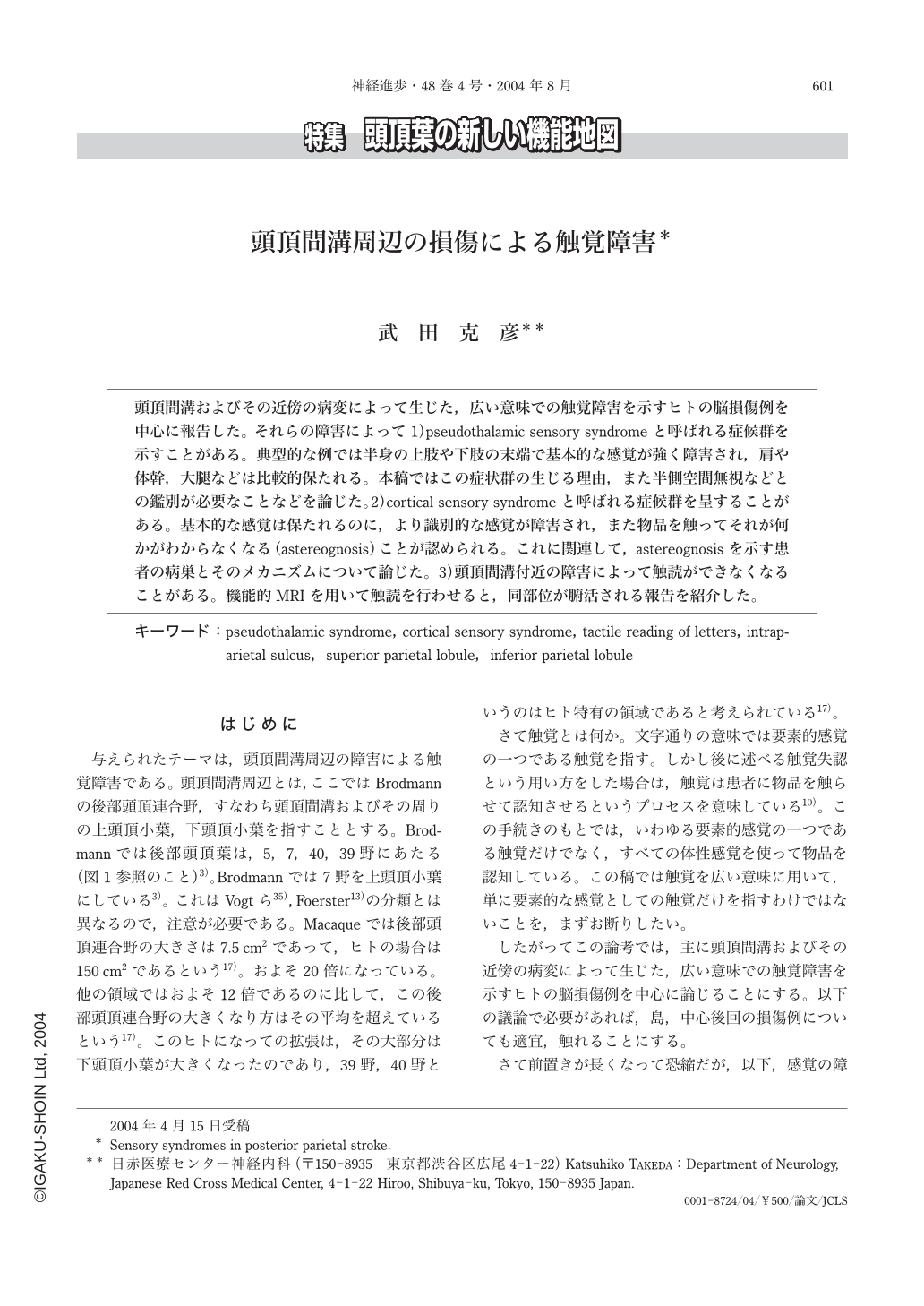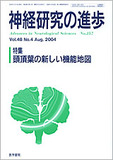Japanese
English
- 有料閲覧
- Abstract 文献概要
- 1ページ目 Look Inside
頭頂間溝およびその近傍の病変によって生じた,広い意味での触覚障害を示すヒトの脳損傷例を中心に報告した。それらの障害によって1)pseudothalamic sensory syndromeと呼ばれる症候群を示すことがある。典型的な例では半身の上肢や下肢の末端で基本的な感覚が強く障害され,肩や体幹,大腿などは比較的保たれる。本稿ではこの症状群の生じる理由,また半側空間無視などとの鑑別が必要なことなどを論じた。2)cortical sensory syndromeと呼ばれる症候群を呈することがある。基本的な感覚は保たれるのに,より識別的な感覚が障害され,また物品を触ってそれが何かがわからなくなる(astereognosis)ことが認められる。これに関連して,astereognosisを示す患者の病巣とそのメカニズムについて論じた。3)頭頂間溝付近の障害によって触読ができなくなることがある。機能的MRIを用いて触読を行わせると,同部位が腑活される報告を紹介した。
I reviewed sensory disturbances following the parietal lobe lesions in human cases. Sensory impairment from parietal stroke can be classified into two main clinical syndromes. Bassetti et al defined the pseudothalamic sensory syndrome as loss of elementary modalities of sensation(touch, pain, temperature, vibration)in a faciobrachiocrural distribution. One patient with pseudothalamic sensory syndrome was able to localize tactile events when forced to point to the stimulated zone with the normal hand, even though the patient does not experience any sensation from that zone. This finding may be a tactual analogue of‘blind sight’. I also discussed why the patients with pseudothalamic syndrome show the topography of one side hemianesthesia, which is usually complete for the distal segments of the upper limb and incomplete for its proximal segments. Preservation of sensation from the arm and shoulder is more likely to represent the contribution of ipsilateral pathways. The lesion necessary to produce pseudothalamic syndrome involved Brodmann's area 40, the posterior insula and the parietal operculum. In the right hemispheric damaged patients with neglect, the lesions clustered in the inferior parietal lobule. So one should examine whether the patients with pseudothalamic syndrome following the right hemispheric lesion show neglect or not, for there is evidence that in right brain damaged patients with visuospatial hemineglect primary sensory process may be largely preserved, even though awareness of contralesional stimuli is defective.
The second major parietal sensory syndrome corresponds to the cortical sensory syndrome. The patients with this syndrome show the combination of impaired position sense and astereognosis with preserved vibration sense. Recently few patients who showed neither elementary sensory disturbances nor the disturbances of intermediate sensory functions(weight perception, tactile localization, and texture discrimination)were reported. The lesions of these patients with astereognosis, however, are not clustered within the parietal lobe. There are reports of astereognosis not only with damage to the postcentral gyrus, but also to the inferior and superior parietal lobule. This heterogeneity might be explained by methodological differences, but also reflects the complexity of functions involved in sensory function.
Recently a patient who manifested a bilateral reading disorder through the somaesthetic modality, without deficit of elementary tactile sensation or tactile object naming due to a left parietal infarct was reported. This patient's disorder shows a lesion involving the intraparietal sulcus, the upper part of the inferior parietal lobule and the adjacent white matter in the left hemisphere may be capable of compromising the pathways for somaesthetic letter reading with both hands. We used functional MRI to investigate the neural basis for tactile reading of Japanese phonograms(kana)with the left hands of normal Japanese subjects. The region surrounding the left parietal sulcus was activated during the tactile reading task in all subjects. Our experiments and the lesion study of above-mentioned support the essential role of the intraparietal sulcus area in the tactile reading.

Copyright © 2004, Igaku-Shoin Ltd. All rights reserved.


